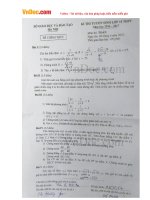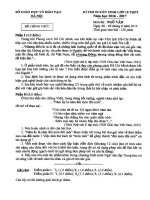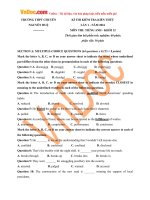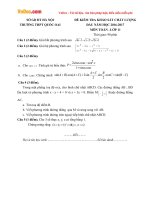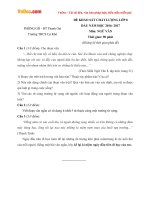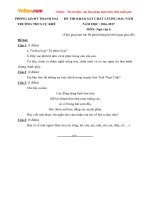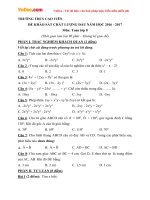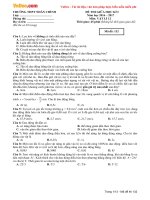Đề thi Hà Nội Open Mathematical Competition 2017 Junior Section
Bạn đang xem bản rút gọn của tài liệu. Xem và tải ngay bản đầy đủ của tài liệu tại đây (113.71 KB, 5 trang )
<span class='text_page_counter'>(1)</span><div class='page_container' data-page=1>
Hanoi Open Mathematical Competition 2017
Junior Section
Saturday, 4 March 2017 08h30-11h30
Important:
Answer to all 15 questions.
Write your answers on the answer sheets provided.
For the multiple choice questions, stick only the letters (A, B, C, D or E) of your
choice.
No calculator is allowed.
Question 1. Suppose x1, x2, x3 are the roots of polynomial
P (x) = x3− 6x2<sub>+ 5x + 12.</sub>
The sum |x1| + |x2| + |x3| is
(A): 4 (B): 6 (C): 8 (D): 14 (E): None of the above.
Question 2. How many pairs of positive integers (x, y) are there, those satisfy
the identity
2x− y2 <sub>= 1?</sub>
(A): 1 (B): 2 (C): 3 (D): 4 (E): None of the above.
Question 3. Suppose n2 <sub>+ 4n + 25 is a perfect square. How many such</sub>
non-negative integers n’s are there?
(A): 1 (B): 2 (C): 4 (D): 6 (E): None of the above.
Question 4. Put
S = 21+ 35+ 49+ 513+ · · · + 5052013+ 5062017.
The last digit of S is
(A): 1 (B): 3 (C): 5 (D): 7 (E): None of the above.
Question 5. Let a, b, c be two-digit, three-digit, and four-digit numbers,
re-spectively. Assume that the sum of all digits of number a + b, and the sum of all
digits of b + c are all equal to 2. The largest value of a + b + c is
(A): 1099 (B): 2099 (C): 1199 (D): 2199 (E): None of the above.
Question 6. Find all triples of positive integers (m, p, q) such that
</div>
<span class='text_page_counter'>(2)</span><div class='page_container' data-page=2>
Question 7. Determine two last digits of number
Q = 22017+ 20172.
Question 8. Determine all real solutions x, y, z of the following system of
equations
x3<sub>− 3x</sub> <sub>= 4 − y</sub>
2y3<sub>− 6y</sub> <sub>= 6 − z</sub>
3z3<sub>− 9z</sub> <sub>= 8 − x.</sub>
Question 9. Prove that the equilateral triangle of area 1 can be covered by
five arbitrary equilateral triangles having the total area 2.
Question 10. Find all non-negative integers a, b, c such that the roots of
equations:
x2− 2ax + b = 0; (1)
x2− 2bx + c = 0; (2)
x2− 2cx + a = 0 (3)
are non-negative integers.
Question 11. Let S denote a square of the side-length 7, and let eight squares
of the side-length 3 be given. Show that S can be covered by those eight small
squares.
Question 12. Does there exist a sequence of 2017 consecutive integers which
contains exactly 17 primes?
Question 13. Let a, b, c be the side-lengths of triangle ABC with a+b+c = 12.
Determine the smallest value of
M = a
b + c − a +
4b
c + a − b +
9c
a + b − c.
Question 14. Given trapezoid ABCD with bases AB k CD (AB < CD).
Let O be the intersection of AC and BD. Two straight lines from D and C are
perpendicular to AC and BD intersect at E, i.e. CE ⊥ BD and DE ⊥ AC.
By analogy, AF ⊥ BD and BF ⊥ AC. Are three points E, O, F located on the
same line?
</div>
<span class='text_page_counter'>(3)</span><div class='page_container' data-page=3>
Hanoi Open Mathematical Competition 2017
Senior Section
Saturday, 4 March 2017 08h30-11h30
Important:
Answer to all 15 questions.
Write your answers on the answer sheets provided.
For the multiple choice questions, stick only the letters (A, B, C, D or E) of your
choice.
No calculator is allowed.
Question 1. Suppose x1, x2, x3 are the roots of polynomial P (x) = x3− 4x2−
3x + 2. The sum |x1| + |x2| + |x3| is
(A): 4 (B): 6 (C): 8 (D): 10 (E): None of the above.
Question 2. How many pairs of positive integers (x, y) are there, those satisfy
the identity
2x− y2 = 4?
(A): 1 (B): 2 (C): 3 (D): 4 (E): None of the above.
Question 3. The number of real triples (x, y, z) that satisfy the equation
x4+ 4y4+ z4+ 4 = 8xyz
is
(A): 0; (B): 1; (C): 2; (D): 8; (E): None of the above.
Question 4. Let a, b, c be three distinct positive numbers. Consider the quadratic
polynomial
P (x) = c(x − a)(x − b)
(c − a)(c − b) +
a(x − b)(x − c)
(a − b)(a − c) +
b(x − c)(x − a)
(b − c)(b − a) + 1.
The value of P (2017) is
(A): 2015 (B): 2016 (C): 2017 (D): 2018 (E): None of the above.
Question 5. Write 2017 following numbers on the blackboard:
−1008
1008, −
1007
1008, . . . , −
1
1008, 0,
1
1008,
2
1008, . . . ,
1007
1008,
1008
1008.
</div>
<span class='text_page_counter'>(4)</span><div class='page_container' data-page=4>
(A): − 1
1008 (B): 0 (C):
1
1008 (D): −
144
1008 (E): None of the above.
Question 6. Find all pairs of integers a, b such that the following system of
equations has a unique integral solution (x, y, z)
(
x + y = a − 1
x(y + 1) − z2 <sub>= b.</sub>
Question 7. Let two positive integers x, y satisfy the condition x2 + y2 ... 44.
Determine the smallest value of T = x3<sub>+ y</sub>3<sub>.</sub>
Question 8. Let a, b, c be the side-lengths of triangle ABC with a + b + c = 12.
Determine the smallest value of
M = a
b + c − a +
4b
c + a − b +
9c
a + b − c.
Question 9. Cut off a square carton by a straight line into two pieces, then cut
one of two pieces into two small pieces by a straight line, ect. By cutting 2017
times we obtain 2018 pieces. We write number 2 in every triangle, number 1 in
every quadrilateral, and 0 in the polygons. Is the sum of all inserted numbers
always greater than 2017?
Question 10. Consider all words constituted by eight letters from {C, H, M, O}.
We arrange the words in an alphabet sequence. Precisely, the first word is
CC-CCCCCC, the second one is CCCCCCCH, the third is CCCCCCCM, the fourth
one is CCCCCCCO,. . . , and the last word is OOOOOOOO.
a) Determine the 2017th word of the sequence?
b) What is the position of the word HOMCHOMC in the sequence?
Question 11. Let ABC be an equilateral triangle, and let P stand for an
arbitrary point inside the triangle. Is it true that
P AB − [[ P AC
≥
\P BC − \P CB
?
Question 12. Let (O) denote a circle with a chord AB, and let W be the
midpoint of the minor arc AB. Let C stand for an arbitrary point on the major
arc AB. The tangent to the circle (O) at C meets the tangents at A and B at
points X and Y, respectively. The lines W X and W Y meet AB at points N and
M , respectively.
Does the length of segment N M depend on position of C?
Question 13. Let ABC be a triangle. For some d > 0 let P stand for a point
inside the triangle such that
</div>
<span class='text_page_counter'>(5)</span><div class='page_container' data-page=5>
Is the following inequality true
|AM | − |P M | ≥ d,
for any position of M ∈ BC?
Question 14. Put
P = m2003n2017 − m2017n2003, where <sub>m, n ∈ N.</sub>
a) Is P divisible by 24?
b) Do there exist m, n ∈ N such that P is not divisible by 7?
</div>
<!--links-->

